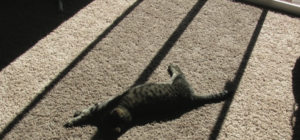
Earlier this year, CATALYST presented A Clean Air Affair—an evening of experts speaking on the topic of air quality. CATALYST worked with the local chapter of the international group PechaKucha 20×20 (20 images, 20 seconds each). The evening kicked off our Clean Air Solutions Fair at Trolley Square. This is the third installment in sharing some of our speakers’ talks.
John Loveless is an electrical engineer by day and an adjunct professor at Weber State University by night, where he teaches an engineering course on renewable energy. He operates the JohnSavesEnergy.com website where he publishes articles on solar power, geothermal energy, efficiency, gardening and electric cars, including a Geo Metro and an electric pickup truck that he converted himself. Meet John Loveless!
John:
I am obsessed with saving energy. And my wife is sick of hearing it all the time so thanks for coming out to hear me.
I love to show people how to cut their energy bills in half. There are many little simple low-lying-fruit-type things you can do.
You could live like this, very simple; there’s some romantic intrigue about that. But I really like conveniences. I like the luxury of the future, like the Starship Enterprise. I have a rule on my website: Save energy without sacrificing conven- ience and luxury. Dang it, I’m an engineer. I want to solve the problems and have the luxuries. Let’s just do that if we want to, right? That was my goal. And my wife, she’s my litmus test. If I make a change and she notices, then I’m doing it wrong. She has to be happy, too.
Lord Kelvin, a real smart guy, once said, “If you can’t measure it, you can’t improve it.” I’ve turned it around to “If you can measure it, you can improve it.”
We have a really big house and it’s contributing to the problem of urban sprawl. But I like our house—I don’t want to move. And that’s where I got my religious conversion to environmentalism. I decided to make it as good as we can.
We started collecting data. We got some baselines of all the energy we use in a year—electricity, natural gas, gasoline for all of our cars. We added it all up and it was a lot of energy and a lot of money—over $5,000 a year. So we began making changes. By 2016, our energy consumption was down by 71%. And our house was actually more comfortable and also less expensive to operate because now our energy was almost all solar power.
Here is an example. You have a microwave oven with a clock. That clock uses more energy than it takes to run the microwave for two and a half minutes. What are you gonna do about it? Nothing. But at least now you know, right? There are a lot of leaky appliances in our homes.
Everyone needs to get one of these power meters. You can go around your house and measure what all your appliances are consuming and wasting. And when you find that something is wasting power, you can make changes and save. There’s a ton of ways you can do that.

Light bulbs is the easiest one. If you’re still doing incandescent bulbs—just don’t! Get with the 21st century. Get some LED bulbs. They’re inexpensive now, and they last a long time.
Don’t go out and buy a new appliance just because. If you need to replace an appliance, shop around for a really energy efficient one— it will soon pay for itself, a refrigerator especially, and certainly if your old fridge is really old.
Old laptop computer? If it’s getting slow, upgrade the hard drive. Not only will it save a little bit of power but it will run faster and you’ll get another two years out of your old laptop. Same with the PC, upgrade the power supply and it all of a sudden becomes more energy efficient. With a faster hard drive, you can sleep the thing faster, wake it up faster.
Insulation. Have tons of insulation in your attic, and air seal your house by taking care of drafts and leaks. Those two—insulation and air sealing—are huge.
Get a blanket for your water heater. They cost about $20. That alone saves you $7 a month on natural gas. You won’t notice any difference. It just stops the leakage and makes the appliance more efficient.

My cat is a genius, I have to say. She not only lies in the sun because it’s warm, she actually picked where the screen was so it wasn’t too warm. So in the winter, you can remove those screens and let more heat into your house. Free heat. This is a real golden goose. Seriously.
It can be bitter cold outside but if it’s sunny and your house is well-insulated and air sealed, it will warm itself passively. It’s all about good insulation and air sealing. And south-facing windows.
You want to make sure those windows don’t let in too much heat in the summer, so have some type of a shade that can cover up. And also in the winter, you can close them at night for better insulation.

Here’s the power graph of my home on a really cold New Year’s Day—single-digit temperatures. The yellow line is the solar panels, the sunlight. The red line is the heater of the house. It turns off at 10am because the sun is doing its job. It doesn’t have to run until 5 or 6 pm after the sun has set. So it was passively heated that day.
That’s the five-minute version of a 6- or 10-week course I teach.
Thank you for listening.
